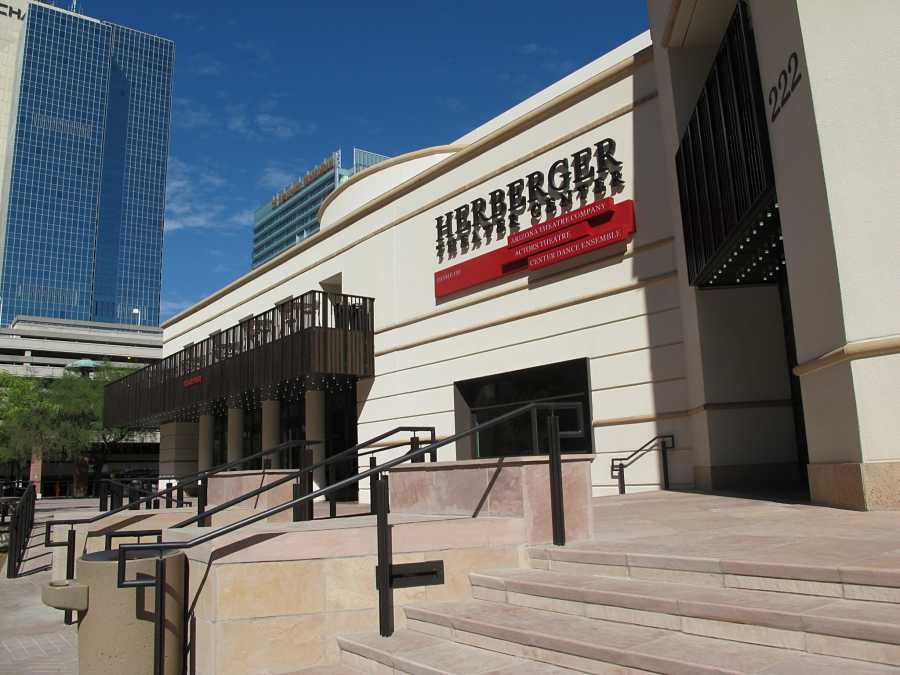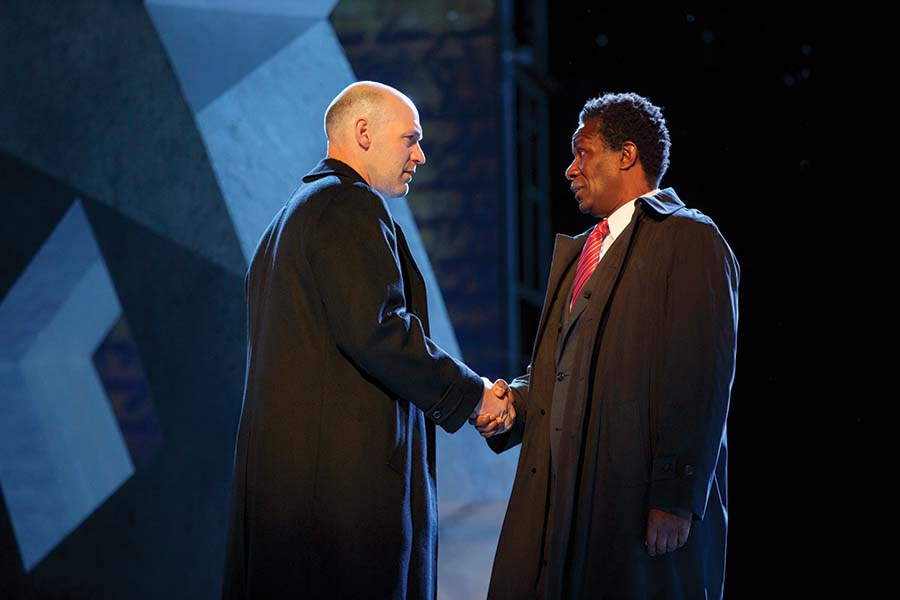In my work as Milwaukee Repertory Theater’s managing director, I’m lucky to be able to draw on the knowledge of two longtime former leaders of the theatre, retired managing director Sara O’Connor and artistic director Joseph Hanreddy. Over separate dinners last fall, they shared with me a common observation: The job of theatre leaders has changed tremendously over the years, and adding to the complexity is the increasing challenge of fundraising.
A 2014 report by the Public Policy Forum in Milwaukee, “Give and You Will Receive,” showed that while some giving categories had experienced reductions in their share of contributions, the arts experienced the most severe decline by far, with its share dropping by nearly 50 percent from 1989 to 2011, while giving to education and community doubled. Meanwhile the Greater Milwaukee metropolitan area experienced a 147-percent increase in the number of arts nonprofits. Giving to the arts as a percentage of charitable giving tightened, while the choices available to donors exploded.
With government and corporate support decreasing for almost all but the largest regional theatres nationwide, even at the best of times, as O’Connor and Hanreddy pointed out, fundraising has become a job for the entire theatre staff and board, from the leadership on down. But what happens when a situation demands that a theatre must quickly raise large sums of money in the worst of times? Last year provided three instructive examples of exceptionally resilient theatres who faced widely different but similarly challenging situations: a natural disaster, a financial crisis, and a staging controversy heard ’round the world.
Houston’s Alley Theatre was riding a high, having completed a beautiful $46.5 million renovation in 2015, its first major renovation since 1968. At a recent League of Resident Theatres (LORT) conference hosted by the Alley, theatre leaders from around the country enviously gazed upon the Alley’s gorgeous public spaces and the brilliantly conceived Hubbard Theatre. Managing director Dean Gladden welcomed us all at the opening reception. I remember thinking that his work on that capital campaign would likely go down as the most challenging and rewarding accomplishment in his highly regarded career, and how great it would be for him to get to enjoy the fruits of his labor for the years to come.
Mother Nature had other plans.
The Alley season looked to be off to a great start with the highly anticipated world premiere of Rajiv Joseph’s Describe the Night, set to open Sept. 15. But Hurricane Harvey, which would prove to be the costliest tropical hurricane on record, with nearly $200 billion in damage, made landfall in late August, devastating everything in its path, including the Alley and the city of Houston. In the early hours after the storm, Gladden didn’t know the effect on the theatre until Joseph posted a video showing the flooded exterior.
Weeks later, Gladden placed estimates of the damage at nearly $18 million as he pored over contractor bids. What about insurance? Gladden explained that the theatre’s $125 million general insurance policy “does not cover flooding, which has to be secured separately. After Hurricane Allison in 2001, we couldn’t purchase flood insurance, and when we finally did, it was very limited because the provider wouldn’t agree to a higher limit. Our insurance carrier has informed us we have $3 million of coverage on the building, $4 million on artistic content, and $300,000 for business interruption.” In other words: Insurance would cover about 40 percent of the loss at best, with an additional $11 million needed, setting the stage for another Gladden fundraising miracle.
Harvey didn’t just damage the Alley’s building; it ravaged the personal and family lives of its staff and decimated critical communications infrastructure. Sets had to be rebuilt, shows had to be relocated, construction and remediation had to begin. Forensic accountants had to be engaged to determine losses for business-interruption insurance.
And yes, money had to be raised—once the patron and donor database was rescued and restored. Gladden now looks ahead with both hope and pragmatism. “When it comes to fundraising, we’re going to have to make the civic case,” he said. “There are only five cities in the nation that have resident companies in all the major art forms. You cannot be competitive as an elite city unless you have the finest in the arts, and Houston is an important major player. We know that culture and cuisine are hugely important to attracting talent and tourism.”
Certainly the Alley has a strong civic case it can leverage with donors, but when asked about anticipated challenges, Gladden wasn’t Pollyanna-ish either.
“First off, we still have donors paying on their pledges from the previous campaign,” Gladden said. “Second, there is devastation in the entire city and a lot of need, so funders are getting hit up for other worthy causes. We know that we are going to have to look to our closest friends, but the Opera and the Ballet got hit hard as well, and we are going to be leaning on some of the same people.”
Given the singularity of Hurricane Harvey and the unprecedented financial and human costs involved, it will take the support of the country to help heal the city. To assist staff, the Alley set up an emergency staff fund; theatres and donors from across the country helped raise $182,000. Additional assistance from national foundations may still be required. But one thing is for certain: Its response to the flood has earned the theatre the hashtag #AlleyStrong. [Note: This report was completed before the sudden departure of longtime Alley artistic director Gregory Boyd amid a storm of harassment allegations. – Ed.]

A few states to the west, it wasn’t a natural disaster that tested the new leadership of Arizona Theatre Company, but a financial one. After four straight years of posting significant deficits, in 2013 the theatre realized its largest deficit to date—more than $1 million, due to declining revenues and significantly increased expenses. As its 50th anniversary approached, the company announced that $2 million needed to be raised or the season would have to be delayed. Billy Russo, then interim managing director, and consultant Tom Hall saw an opportunity.
“The theatre had one major opportunity to help begin its financial recovery, and that was the 50th anniversary,” Russo explained. “It needed to be an ambitious season in terms of the size of productions and scope of ideas to remind people what put Arizona Theatre Company on the map for the prior 50 years. But we were in such a cash-strapped situation, we had to know that we had at least $2 million committed ahead of time to embark on the season. I didn’t want us to start the season, run out of money, and then close.”
Presenting a more ambitious season for its 50th anniversary was a huge gamble for all involved, but soon ATC’s own deus ex machina appeared in the form of an angel donor. A trustee and Tucson resident, Mike Kasser, issued a $1 million challenge, guaranteeing that at least 50 percent of the needed funding would come from the theatre’s Tucson base, with the hope of raising additional support in the theatre’s second home of Phoenix—which, while generous, gives less per capita dollars than its Tucson donors.
Of course, Russo first looked at several options to address the company’s financial challenges, including three different variants of its 50th anniversary season, ranging in budget size from $6 million to $7.5 million. No matter how he tweaked the numbers, the theatre needed $3 million in contributed revenue to execute the season, with the difference coming from earned revenue; every alternative he considered would place the same amount of pressure on fundraising.
“While the more ambitious season was putting a heavier reliance on contributed income, we thought it was the better option in the long run as it would get more people through the doors and introduce more people into the family,” Russo said. “It also built in an operating surplus to chip away at the accumulated deficit.”
The theatre decided that the $2 million needed to be raised by June 30, the end of their fiscal year, but the message wasn’t released publicly until June 26, so the deadline was extended to July 15, giving them just three weeks to raise the necessary funds. “We didn’t have enough time to figure out a sophisticated campaign. It was an all-hands-on-deck situation, and it felt a little seat-of-our-pants at the time,” Russo conceded.
Given the time constraints, the company relied heavily on email appeals, working the phones, and in-person asks from trustees, leadership, and staff. Local politicians, including the mayors of Tucson and Phoenix, stepped up, helping to drive corporate donations, though not in huge amounts. Most donations came from loyal subscribers and individual donors, who dug deep to rescue a theatre that had given them decades of memories. But many donors had the same question: “Will I get my donation back if the campaign isn’t successful and the thea-tre season is abandoned?”
To reassure donors, ATC decided to accept only pledges with a specified payout schedule until such time that the full amount was pledged. Not only did this provide an acceptable solution to the single largest concern of donors; in practice it also protected them from a potential bankruptcy. As Russo explained, “If we accepted cash and the campaign wasn’t successful, then creditors would be able to get access to donations even if a season could not be produced. In a potential bankruptcy situation, donors must all be treated the same. You can’t give back to some and not others. I couldn’t assure everyone would get their money back if we weren’t successful, so this was the only way.”
A little more than a year later, it is clear that the gamble paid off. The money was raised and the more ambitious 50th anniversary season was produced, realizing a considerable surplus, primarily from a subscriber base that increased by 15 percent and single tickets that grew by 46 percent over the prior year. “We knew it was a risk, but it was a calculated risk,” Russo confirmed. “What was amazing about it was there was a lot of debate if there was enough support and a sense of value for the theatre to be supported at a higher level, and that answer came back strongly yes! It helped us answer what value the public places on the theatre and what our place is in the state.”
Looking back, Russo offered a few words of caution: “In an emergency situation, you must move fast, but everyone needs to be on the same page regarding the intention of the campaign so the messaging is completely clear. And you need to have a clear sense of what benchmarks need to be met along the way so that the final decision is made against those benchmarks to allow the theatre to prepare either way. It is a very emotional time, but you need an ability to make non-emotionally based decisions.”
With Russo now the full-time managing director and the recently named artistic director David Ivers in place, Arizona Theatre Company’s turnaround seems well underway, although with success comes a new challenge. “With the success of last season, people believe that everything is great and wonderful now,” Russo said. “While we made an enormous stride toward recovery, there is still work to do in terms of contributed revenue and ticket sales to complete a financial recovery and realize a new vision for the company of new executive leadership.”

While the new leadership in Arizona was busy righting their ship, last summer New York City’s Public Theater encountered choppy waters when a Trump-like Julius Caesar caused a public relations challenge unlike any the theatre had faced in recent times. The course was charted shortly after the 2016 election, when artistic director Oskar Eustis decided to stage Shakespeare’s Roman history with a presidential lookalike as the bloodily assassinated title character in the Delacorte Theater’s high-profile summer season. Given the politically divisive climate of the country, executive director Patrick Willingham anticipated that the production might raise eyebrows, particularly as it opened less than two weeks after Kathy Griffin’s tendentious decision to share a photograph of herself holding the severed head of an effigy of President Trump.
“We invited donors and sponsors to the final dress rehearsal,” Willingham recalled. “We wanted them to come, see the production, and then hear from them. Also, as corporate sponsors are usually using tickets for client entertainment, we wanted to make sure they knew what the production was before they invited folks.”
While the Public maintained that the production did not intend to incite violence—and that in fact Shakespeare’s play dramatizes the tragic consequences of political bloodshed—Willingham described the reactions to the production as swift and vocal.
“It really felt like the play heard ’round the world,” he marveled. “We were literally in media outlets in nations across the globe. It was a harrowing several weeks, and a lot for the theatre and the staff to deal with. The level of vitriol, hate, and threats that poured into the theatre was frightening.”
It was quickly reported that two corporate sponsors, Delta and Bank of America, pulled their support. The truth was slightly more complicated, Willingham said: “Bank of America has a nationwide set of stakeholders, customers, and investors they have to respond to. I can appreciate that they needed to make a business decision, even if I don’t agree with their position. That said, Bank of America actually never left us; they just reallocated some of their funding to other programs. Delta, on the other hand, pulled their support of the Public altogether.”
But things were moving quickly, and the Public needed to respond. “It took us a few days to react in a way that would allow people to positively express their support,” Willingham said. “People really like to show their support with their money.” They redesigned the homepage of their website to include the message “We Are One Public,” outlining the Public’s commitment to freedom of expression; and they added a prominent “Donate Now” button along with a description of the show, so that everyone who came to the website received the same message highlighting the theatre’s values and the purpose of the production.
To complement their digital strategy, the Public launched a substantial social media campaign at the same time. “We didn’t want to poke our finger in the eye of anyone, but this was an opportunity to send out a very positive message about who we are and why we do what we do,” said Willingham. Artists and friends of the Public showed their support by recording and sending video and text messages that were then retweeted and shared with the Public’s friends and followers.
Meanwhile Planned Parenthood, the ACLU, and the Open Society Foundation all rushed to the Public’s defense, connecting the theatre to organizations that had been thrust into similar imbroglios in recent times. “They shared support and gave us guidance, which was so helpful, since we didn’t have any theatre or culture colleagues that had really gone through this,” Willingham said. “We needed advice from our social-services colleagues.” Open Society, for instance, connected the Public with the film production company Wondros, which filmed a video of well-known Public artists speaking on the importance of creative freedom, which can now be the theatre’s fundraising campaigns.
Ultimately the Public had 2,192 donors from all 50 states and six different countries contribute during Julius Caesar, showing an outpouring of support for the notion that creative freedom is essential to democracy. For all the drama and stress of the controversy, the net financial impact of the production may have been positive. More importantly, it provided a moment for the theatre to clearly express its mission in practical terms.
“We really tried to take the high road,” Willingham said. “Our message was successful because it was authentic—it is true to who we are and the reality of what we produce. The show was about threats to democracy and resolving those threats through democratic means. In producing it, we wanted to communicate what we stand for.”
Perhaps the old saying “the show must go on” suffices to explain the innate ability of theatre professionals to keep driving through crises to fulfill commitments to our patrons, staff, and community. But when extraordinary circumstances align and greatness is thrust upon us, theatres like the ones above demonstrate that a clarity of purpose, communicated in a timely and efficient manner, is the key to survival—and that if we clearly communicate our value and our need, the communities we serve will resoundingly rise to remind us that what we do matters.
Chad Buaman is the managing director of Milwaukee Repertory Theater.


